
I like Redhawks. They are tough revolvers that handle stout handloads without complaint and they are more compact than a Super Redhawk. The full grip frame offers some options not available to Super Redhawk peg grip owners and the absence of a frame extension gives the Redhawk classic appeal. I am not too terribly excited about the Redhawk’s use of its mainspring to power its hammer and to reset its trigger or the 4″ barrel gun’s pinned rather than quick change front sight. However, neither impairs the revolver’s performance, but they respectively complicate trigger jobs and sight changes.
Unlike the Super Redhawk, GP100 and SP101, changing the Redhawk’s mainspring to one of lower compression resistance does not always yield a slick, lightened trigger pull. According to some, reducing the mainspring rate may diminish ignition reliability, citing a marginal mainspring related design, exacerbated by a short firing pin and/or improper hammer/transfer bar fit. Bowen Classic Arms provides their assessment of the problem areas under the sub heading, “December 11, 2011 – Ruger Redhawk Ignition Problems”. Buffalo Bore has an FAQ that seems to suggest that if their ammo doesn’t fire, it’s because of a design flaw in the Redhawk… and numerous other firearms, or gunsmiths who don’t know what they are doing.
The things you read, the things you see…
My personal Ruger Redhawk 4″ in 45 Colt has been shot frequently with a wide variety of factory ammunition and handloads without a failure to fire. I thought I would take each of the comment made by these folks and see if my Redhawk exhibited any of the indicated problems. I am not suggesting that my Ruger is representative of all Ruger Redhawks, however, I am suggesting that sweeping characterizations regarding a firearm type may not apply to all. So before rushing to spend $500 or so to have my firearm repaired, I thought I might check to see if it was actually broken.
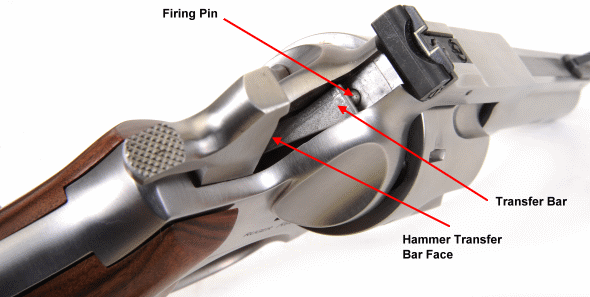
One criticism commonly made is that Redhawks rarely meet the generally accepted standard of 0.050″ to 0.055″ firing pin protrusion. Suggested corrective actions range from minimizing the hammer’s transfer bar face clearance to installing a longer firing pin.
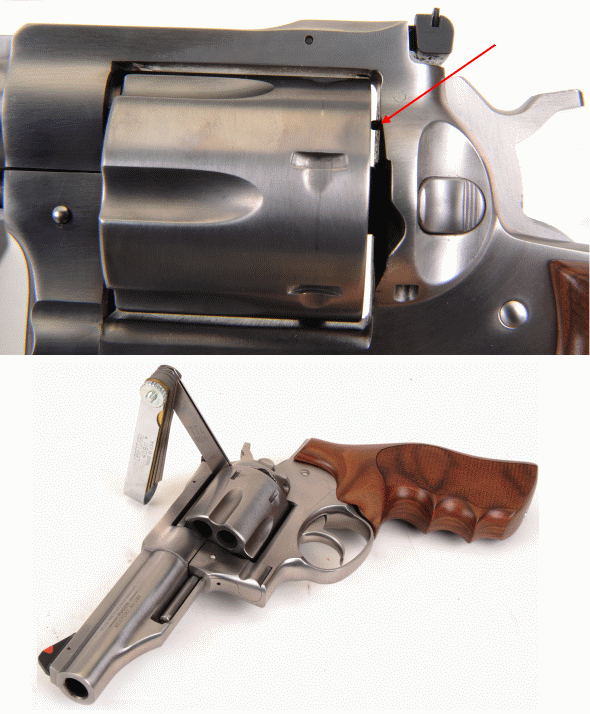
Not a very exotic approach, but… a feeler gauge was used to determine the gap between the revolver’s breech face and aft cylinder face, which checked at 0.063″. As the firing pin does not extend to the rear face of the cylinder, a feeler gauge was used to check the gap between the nose of the firing pin and the rear cylinder face with the hammer down and the trigger not allowed to reset, which checked 0.010″. Subtracting the firing pin clearance from the cylinder to breech clearance yielded a hammer down firing pin protrusion of 0.053″, which is midrange for acceptable firing pin protrusion. No modification required.
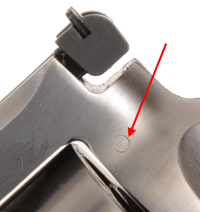 Joe, you seem to have taken an inordinate number of steps to evaluate mechanical firing pin protrusion on this revolver. Why is that? Glad you asked, If firing pin protrusion is OK, fitting a longer firing pin would make no sense at all as the additional allowable 0.002″ would gain nothing and longer could be unsafe.
Joe, you seem to have taken an inordinate number of steps to evaluate mechanical firing pin protrusion on this revolver. Why is that? Glad you asked, If firing pin protrusion is OK, fitting a longer firing pin would make no sense at all as the additional allowable 0.002″ would gain nothing and longer could be unsafe.
Of greater concern, if the pin were found to be out of spec it would need to be replaced with a new fitted piece. The firing pin resides in a recoil plate, suspended within a rebound spring. That assembly is held in place within the frame with a recoil plate cross pin. See the arrow? That is the recoil plate cross pin end, which is contoured to the frame on both ends and final finished with the rest of the firearm. Not a casual task to take on. So, Yippee! This firing pin is good to go.
Light spring, heavy spring or just right….
Bowen Classic Arms suggests that reducing mainspring rate on a Redhawk invites ignition problems and go on to recommend an increase in mainspring rate over factory standard, if changing to a longer firing pin does not correct original ignition problems. Wolff Springs indicates that the factory installs a 17 Lbs spring, Bowen Arms indicates 20 Lbs. I am sure both have been standard at one point or another in the Redhawk’s production cycle, but each of these sources follows a different path to improving the Redhawk’s function.
Wolff Gunsprings sells reduced power springs, which is consistent with GP100 and Super Redhawk trigger pull lightening approaches. They do not offer an extra powder spring, as they do with some firearms. The available rates are 12, 13 and 14 Lbs, available individually or as a set for folks who like to experiment. Bowen Arms offers extra power springs in 30 Lb and 40 Lb ratings, however, they do not offer reduced power springs. Each approach is true to the sources objectives as Wolff’s intention is to reduce trigger pull and Bowen’s is to add assurance of ignition by increasing hammer velocity.
Installing a heavier spring was probably not in the cards as my Redhawk did not have an ignition problem and my objective was to reduce trigger pull without jeopardizing ignition reliability. Rather than incrementally reduce rates, the lightest 12 Lb spring was installed and checking and testing was done with that as a baseline. A simple dial indicator was set up as a depth gauge and a couple of V Blocks were used to suspend each cartridge by its rim when taking measurement.
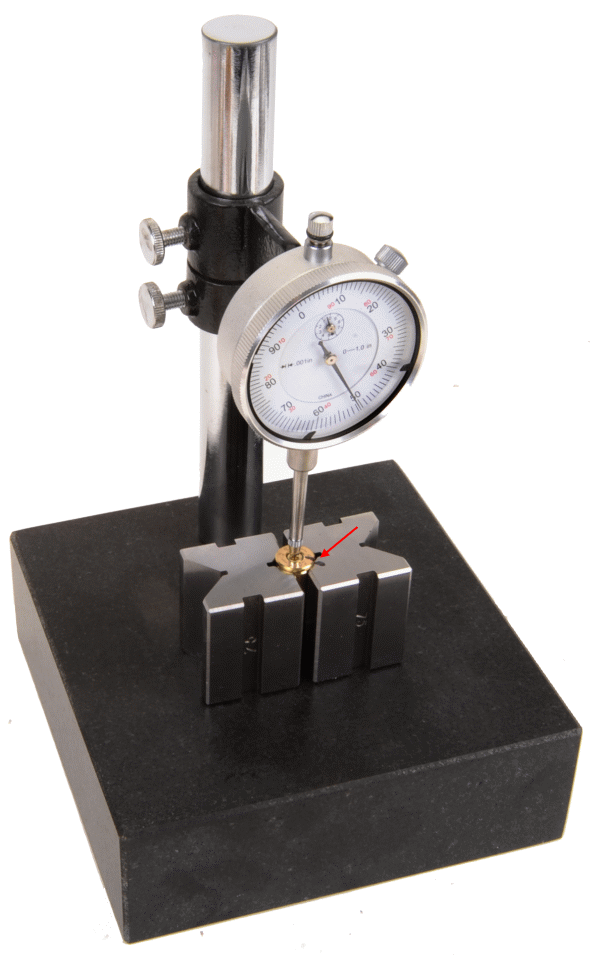
Thinking the rim thickness measurement was going to remain unchanged, I initially took a reading at the center of the rim without marking location. Unfortunately, rims are not always true to the case centerline around their entire circumference and firing a cartridge can alters that relationship. So each case was indexed to a location on the V Blocks so comparable post firing measurements could be taken. Readings were taken from the V Block face as a zero reference point, centrally on the case rim and on the primer face. The cases were assigned a control number, original dimensions were recorded and then the same points were measured after firing and compared. The dial indicator tip ends in a small radius which allowed measuring to the bottom of the firing pin indentation.
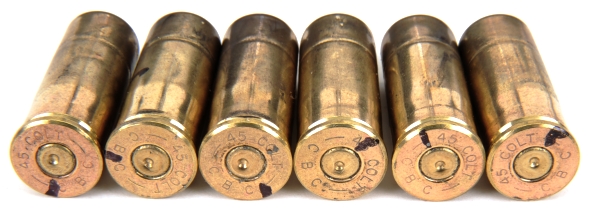
| # | Ammo | Rim Thickness Unfired “ |
Primer Seating Depth “ |
Primer From Breech Face” |
Firing Pin Impression Depth “ |
Firing Pin Travel From Breech Face” |
Ignition Y/N |
Mainspring Rate Lbs. |
| 1 | MagTech – Cowboy | 0.052 | 0.003 | 0.014 | 0.011 | 0.025 | Y | 12 |
| 2 | MagTech – Cowboy | 0.052 | 0.002 | 0.013 | 0.013 | 0.026 | Y | 12 |
| 3 | MagTech – Cowboy | 0.051 | 0.002 | 0.014 | 0.013 | 0.027 | Y | 12 |
| 4 | MagTech – Cowboy | 0.054 | 0.003 | 0.012 | 0.017 | 0.029 | Y | 12 |
| 5 | MagTech – Cowboy | 0.056 | 0.004 | 0.011 | 0.013 | 0.024 | Y | 12 |
| 6 | MagTech – Cowboy | 0.055 | 0.003 | 0.011 | 0.017 | 0.028 | Y | 12 |
| 1 | MagTech – Cowboy | 0.053 | 0.003 | 0.013 | 0.016 | 0.029 | Y | 17 |
| 2 | MagTech – Cowboy | 0.055 | 0.005 | 0.013 | 0.021 | 0.034 | Y | 17 |
| 3 | MagTech – Cowboy | 0.055 | 0.005 | 0.013 | 0.019 | 0.032 | Y | 17 |
| 4 | MagTech – Cowboy | 0.055 | 0.004 | 0.012 | 0.014 | 0.026 | Y | 17 |
| 5 | MagTech – Cowboy | 0.057 | 0.004 | 0.010 | 0.020 | 0.030 | Y | 17 |
| 6 | MagTech – Cowboy | 0.054 | 0.006 | 0.015 | 0.017 | 0.032 | Y | 17 |
| – | ||||||||
| 1 | Cor®Bon DPX | 0.056 | 0.004 | 0.011 | 0.013 | 0.024 | Y | 12 |
| 2 | Cor®Bon DPX | 0.054 | 0.003 | 0.012 | 0.013 | 0.025 | Y | 12 |
| 3 | Cor®Bon DPX | 0.056 | 0.004 | 0.011 | 0.015 | 0.026 | Y | 12 |
| 4 | Cor®Bon DPX | 0.057 | 0.004 | 0.014 | 0.013 | 0.027 | Y | 12 |
| 5 | Cor®Bon DPX | 0.054 | 0.002 | 0.011 | 0.016 | 0.027 | Y | 12 |
| 6 | Cor®Bon DPX | 0.056 | 0.003 | 0.010 | 0.014 | 0.024 | Y | 12 |
| 1 | Cor®Bon DPX | 0.060 | 0.004 | 0.007 | 0.018 | 0.023 | Y | 17 |
| 2 | Cor®Bon DPX | 0.055 | 0.003 | 0.011 | 0.021 | 0.034 | Y | 17 |
| 3 | Cor®Bon DPX | 0.056 | 0.003 | 0.010 | 0.016 | 0.026 | Y | 17 |
| 4 | Cor®Bon DPX | 0.056 | 0.004 | 0.011 | 0.021 | 0.032 | Y | 17 |
| 5 | Cor®Bon DPX | 0.054 | 0.004 | 0.013 | 0.020 | 0.033 | Y | 17 |
| 6 | Cor®Bon DPX | 0.054 | 0.003 | 0.012 | 0.018 | 0.030 | Y | 17 |
| – | ||||||||
| 1 | Barnes Vortex | 0.058 | 0.003 | 0.008 | 0.014 | 0.022 | Y | 12 |
| 2 | Barnes Vortex | 0.056 | 0.002 | 0.009 | 0.016 | 0.025 | Y | 12 |
| 3 | Barnes Vortex | 0.058 | 0.004 | 0.009 | 0.013 | 0.022 | Y | 12 |
| 4 | Barnes Vortex | 0.059 | 0.004 | 0.008 | 0.015 | 0.023 | Y | 12 |
| 5 | Barnes Vortex | 0.056 | 0.001 | 0.008 | 0.015 | 0.023 | Y | 12 |
| 6 | Barnes Vortex | 0.059 | 0.004 | 0.008 | 0.013 | 0.023 | Y | 12 |
| 1 | Barnes Vortex | 0.055 | 0.004 | 0.012 | 0.016 | 0.028 | Y | 17 |
| 2 | Barnes Vortex | 0.055 | 0.004 | 0.012 | 0.019 | 0.031 | Y | 17 |
| 3 | Barnes Vortex | 0.054 | 0.003 | 0.012 | 0.020 | 0.032 | Y | 17 |
| 4 | Barnes Vortex | 0.056 | 0.002 | 0.009 | 0.017 | 0.026 | Y | 17 |
| 5 | Barnes Vortex | 0.056 | 0.003 | 0.010 | 0.020 | 0.030 | Y | 17 |
| 6 | Barnes Vortex | 0.054 | 0.003 | 0.012 | 0.021 | 0.033 | Y | 17 |
The table, above, represents one of four lots of the same ammunition and spring rates that were processed. In total, 48 rounds of each ammo type were fired; 24 with light springs, 24 with factory springs for a total of 192 rounds.
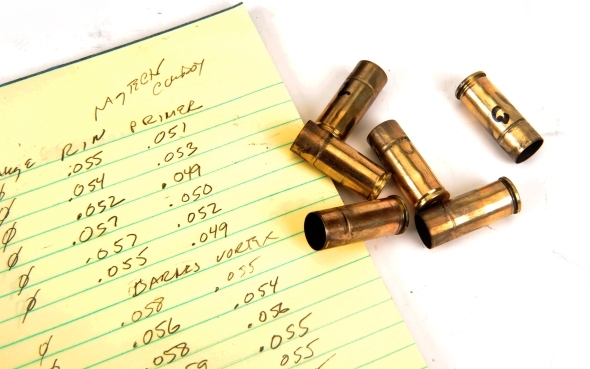
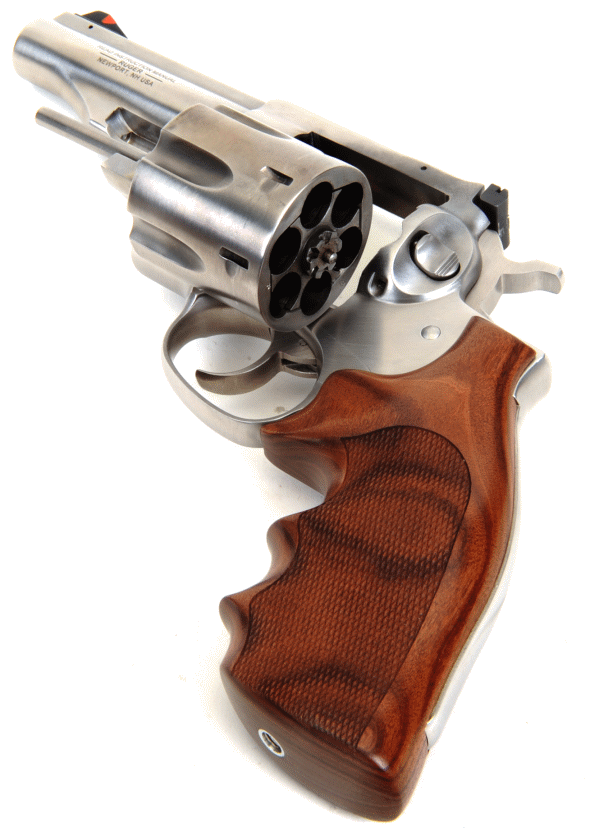

Email Notification